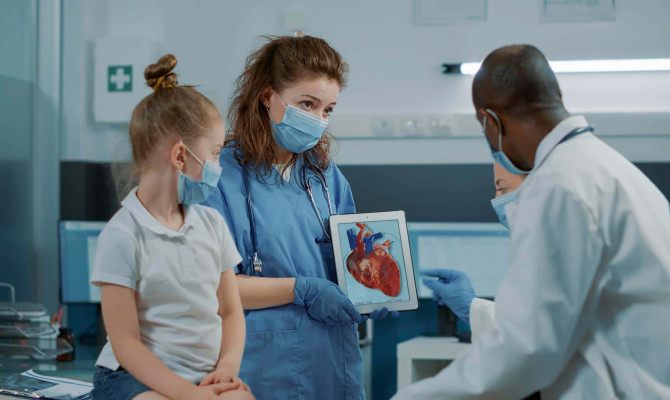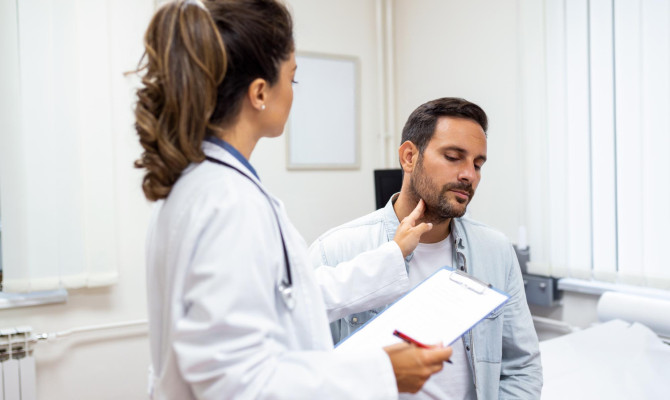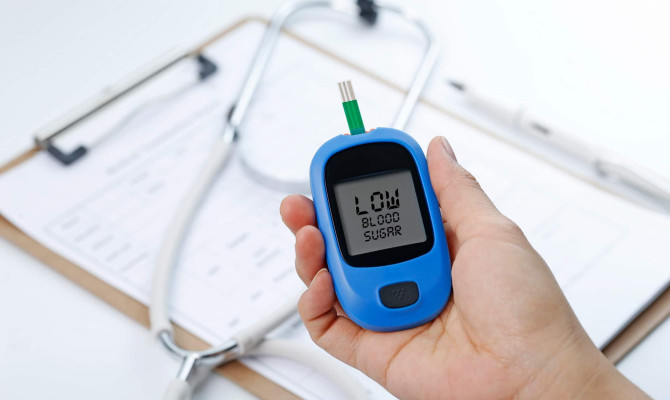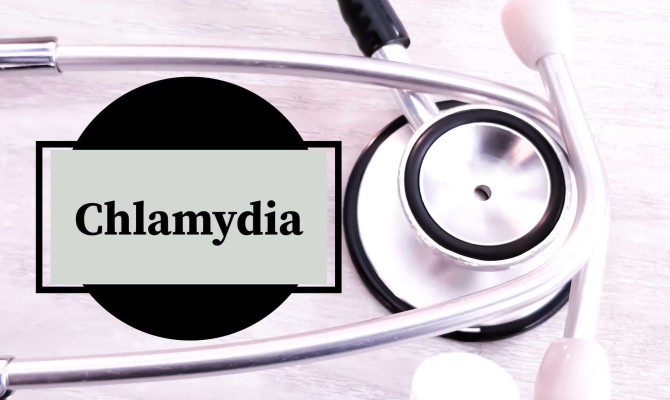Unraveling the Complexities of Stroke: Causes, Prevention, and Rehabilitation

- Stroke
- 29 Aug 2023
Introduction
What is a Stroke?
A stroke is a condition that happens when something restricts the blood flow to a specific area of the brain or when a blood vessel in the brain bursts. In either situation, the brain gets damaged, causing long-term disabilities, permanent brain damage, and/or death in the affected people. Despite some people having a higher risk than others, everyone, including children and adults, can have a stroke. Approximately two-thirds of strokes in adults over 65 develop as people age, making strokes more prevalent. Type 2 diabetes, high cholesterol, high blood pressure, a history of heart attack, and/or irregular cardiac rhythms are a few risk factors that can cause Stroke. 1Introduction | Researched based study from Centers for Disease Control and Prevention 2Introduction | Researched based study from Cleveland Clinic Main Campus

Types
Types of Stroke
There are two main categories for strokes, namely:
- Ischemic Stroke
- Hemorrhagic Stroke
Ischemic Stroke:
- This type of stroke, which is the most frequent, occurs when a blood clot or arterial blockage decreases blood flow to the brain.
- It reduces blood flow to other brain regions and inhibits oxygen and nutrients from reaching brain cells, which causes the disorder’s symptoms.
Hemorrhagic Stroke:
- This stroke type, which is the second most frequent, is characterized by a blood artery rupture that causes blood to leak in or around the brain in affected individuals.
Transient ischemic attack:
- Also known as a mini-stroke, it differs from other types of Strokes since the blood supply to the brain in this type of Stroke is restricted only for a brief period that usually lasts not longer than 5 minutes. 3Types | Researched based study from National Institute of Hydrology
Causes
Causes of Stroke
Ischemic Stroke:
- Blood clotting disorders
- Atherosclerosis (hardening/thickening of the arteries)
- Heart diseases
- Atrial fibrillation (irregular heart rhythm).
Hemorrhagic Stroke:
- High blood pressure
- Brain (cerebral) aneurysms (bulge/weakened area in a blood vessel in the brain)
- Diseases that weaken or create strange alterations in the blood vessels in the brain
- Brain tumor. 4Causes | Researched based study from National Institute of Hydrology
Risks
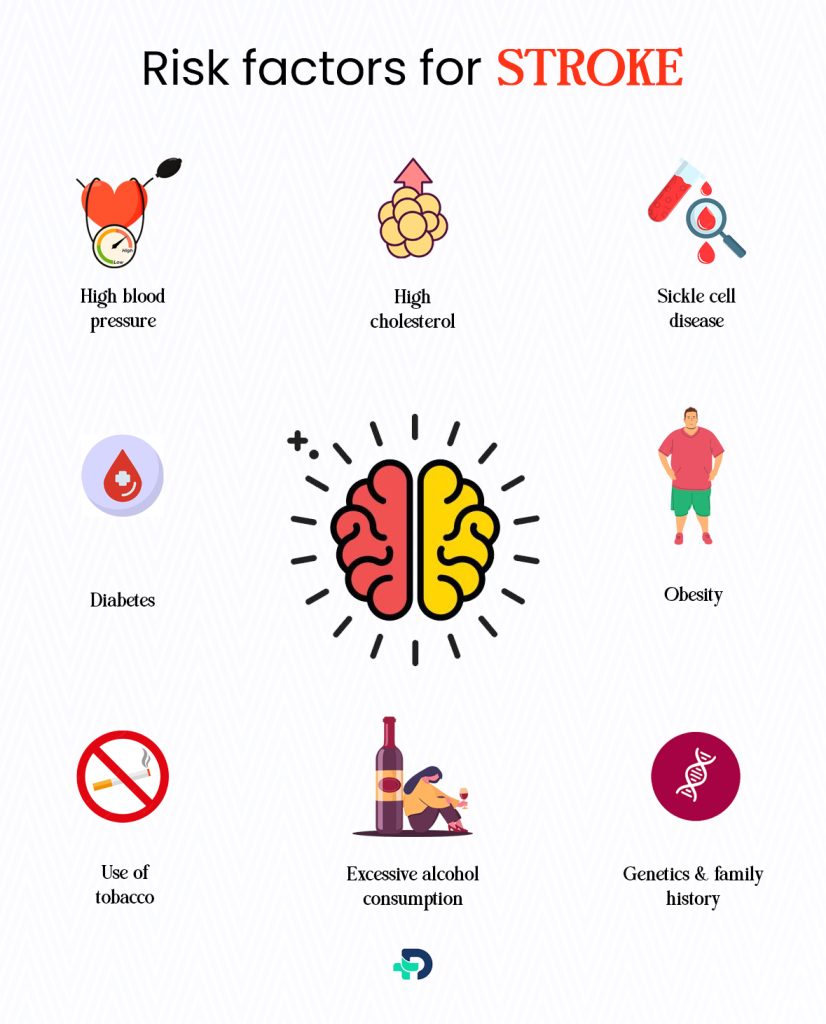
What are the Risk factors?
A stroke can happen to anyone at any age, but some factors can increase the chances of getting a stroke which may include:
- High blood pressure
- High cholesterol
- Diabetes
- Obesity
- Sickle cell disease (a blood disorder)
- Excessive alcohol consumption
- Use of tobacco
- Genetics & family history. 4Risks | Researched based study from National Institute of Hydrology
Symptoms
What symptoms indicate Stroke?
The following are few symptoms of stroke:
- Sudden numbness or weakness, usually on one side of the body, in the face, arm, or leg
- Lack of coordination, or loss of balance
- Confusion, difficulty while speaking, and/or difficulty while understanding speech
- Sudden difficulty viewing from one or both eyes
Schedule an immediate appointment with your doctor if you experience any of the symptoms listed above. 1Symptoms | Researched based study from Centers for Disease Control and Prevention
Diagnosis
How is Stroke diagnosed?
A healthcare professional typically uses a neurological exam, diagnostic imaging, and/or other methods to identify a stroke.
Neurological examination:
The medical professional may ask you to do specific tasks or respond to certain questions during this evaluation. When you perform these tasks or answer the questions, the provider will watch for any telltale indications that indicate a problem with how a specific portion of your brain works.
Diagnostic tests:
The following tests may be recommended to diagnose a stroke which may include:
- Imaging tests such as computerized tomography (CT) scans, magnetic resonance imaging (MRI) scans
- ECG to ascertain whether cardiac illness is the condition’s primary cause.
- Blood tests at the lab to look for signs of infection or heart damage and to measure clotting ability and blood sugar levels that may help with the diagnosis. 2Diagnosis| Researched based study from Cleveland Clinic Main Campus
Treatment
Treatment
Is there a cure for Stroke? How is it treated?
The following treatments may be used depending on the type of stroke:
Ischemic stroke therapy:
- The most often used form of stroke treatment for blood clot-related strokes is drug therapy, which includes:
Antithrombotic drugs:
- Medicines that stop the growth of new blood clots which can block an artery leading to the brain and result in strokes. (Ex. warfarin, heparin)
Thrombolytics:
- Medicines that cure strokes by dissolving the blood clot blocking the blood flow to the brain. (Ex. streptokinase, alteplase).
Treatment for hemorrhagic Stroke:
The treatment for a hemorrhagic stroke includes locating and treating the cause of bleeding, which generally necessitates surgery/other methods to stop the bleeding or reduce any cerebral pressure on the brain, such as:
- Angioplasty
- Percutaneous coronary intervention (stenting)
- Carotid/surgical endarterectomy
Angioplasty:
- It is a treatment used to open up coronary arteries (the blood vessels that supply blood to the heart) that have been blocked due to coronary artery disease or narrowing.
- Helps in restoring blood flow to the heart muscle without requiring an open heart surgery.
Percutaneous coronary intervention (stenting):
- Is a procedure that involves inserting a stent, a thin metal tube, inside the blocked artery to keep it open and reduce the risk of further arterial narrowing.
Carotid/surgical endarterectomy:
- It is a surgical treatment in which the doctor eliminates fatty deposits blocking one of the two carotid arteries, allowing blood to circulate freely and preventing Stroke.
Stroke Rehabilitation:
Supporting a patient in recovering from or adjusting to the changes in their brain is one of the most important components of stroke treatment which is an essential part of the recovery process, which can take a variety of forms, such as:
- Speech therapy (aids in regaining language and speaking abilities)
- Physical therapy (aids in regaining the ability to use hands, arms, feet, and/or legs)
- Occupational therapy (helps to retrain the brain to improve precise hand movements and muscle control)
- Cognitive therapy (helps to resolve memory problems and/or concentration). 2Treatment| Researched based study from Cleveland Clinic Main Campus
Prevention
Can Stroke be prevented?
The following measures can help avoid strokes which includes
- Changing your way of life (such as indulging in regular exercise and having a healthy food in your daily routine)
- Avoiding risky lifestyle choices or making changes to your behaviors (such as quitting smoking, tobacco/recreational drug use)
- Planning an annual visit to the healthcare provider for check-ups and wellness
- Maintaining a healthy weight. 5Prevention| Researched based study from National Health Service
Prognosis
Prognosis:
The prognosis of a stroke varies based on a variety of circumstances. These considerations include your medical history, the location of the Stroke in your brain, and how severe the condition is. When severe or untreated for a long time, strokes have the potential to result in death. To avoid such circumstances, consult your doctor and follow the preventive measures. 2Prognosis| Researched based study from Cleveland Clinic Main Campus
Takeaways
Takeaways:
- A stroke is a condition that happens when something restricts the blood flow to a specific area of the brain or when a blood vessel in the brain bursts.
- Patients with blood clotting disorders, atherosclerosis (hardening/thickening of the arteries), heart diseases, high blood pressure, and/or brain aneurysms are more prone to develop Stroke.
- Sudden numbness/weakness in the face, arm/leg, confusion, difficulty while speaking, loss of balance, and/or lack of coordination are a few symptoms associated with the disease.
- Stroke is diagnosed by neurological examination, diagnostic imaging, and/or lab tests by the healthcare provider.
- Stroke can be prevented by improving lifestyle, avoiding risky lifestyle choices, planning an annual visit to the healthcare provider (for check-ups and wellness), and maintaining a healthy weight. 2Takeaways | Researched based study from Cleveland Clinic Main Campus
Any feedback on this article?
 This Articles content was accurate
This Articles content was accurate Very Informative Article
Very Informative Article I have a question or a comment
I have a question or a comment
 This article contains inaccurate content
This article contains inaccurate content This article was not helpful
This article was not helpful I have a question or a comment
I have a question or a comment
We appreciate your helpful feedback!
Checkout our social pages
References
-
Centers for Disease Control and Prevention
Introduction | Symptoms
-
Cleveland Clinic Main Campus
Diagnosis | Treatment | Prognosis | Takeaway
-
National Institute of Hydrology
Types | Takeaway
-
National Institute of Hydrology
Causes | Risks
-
National Health Service
Prevention













